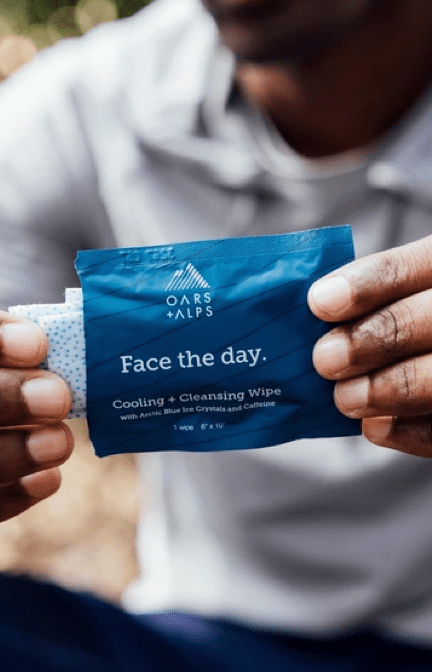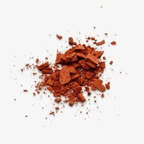Ingredients
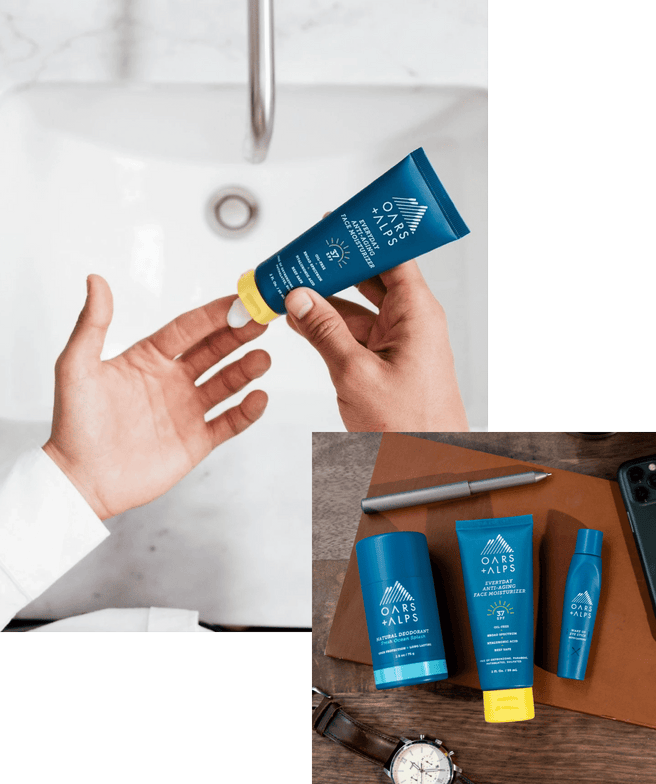
Skincare Ingredients 101
The average guy’s grooming product is designed with low cost in mind and may contain harsh chemicals that can make you more likely to break out, dry out your skin, or worse. Oars + Alps was built on a mission to do things a better way—to bring you skincare that promotes the health of your skin, not the other way around.
Every Oars + Alps product is carefully formulated with the highest quality, clean ingredients to be just as, and often more, effective than everyday brands. We never use moisture-stripping Sulfates or Phthalates, nor do we use Parabens that may disrupt your hormonal balance. Read on to learn what your skincare should really be doing for your skin.
Oars + Alps bans more than 1,800—and counting.
What Skincare Should Do For Your Skin

• Hyaluronic Acid
• Vitamin E
• Vitamin B5
• Jojoba Oil
• Shea Butter
Maintain Moisture
Giving men’s skin cells the moisture they need for peak performance has more benefits than just making it look great. Moisturized skin is less likely to break out and become irritated
What are the best skincare ingredients for maintaining moisture balance?
We’ve found that the perfect mix doesn’t simply feed your skin more moisture—it increases moisture capacity altogether. Hyaluronic Acid absorbs 1000 times its weight in moisture and drives it deep into the skin. Vitamins help moisturize and heal, while plant-based oils hydrate and seal in moisture.
Reduce Inflammation
Your skin is your body’s first line of defense, protecting you from infection, supporting your immune system and fighting inflammation. Your skincare should strengthen and support your skin in playing those roles. However, products made with harsh ingredients can disrupt the skin’s balance and actually be the cause of inflammation and irritation.
One study showed over 50% of men say they have sensitive skin. Our take is that some of them are using products that create imbalance in the microorganisms that live on the skin. The ingredients we use are effective while strengthening the natural functions of the skin.
Which skincare ingredients support antimicrobial immunity and reduced inflammation?
Finding the right balance of cleansing and calming can be tough. We encourage cleansing with non-drying, Sulfate-free ingredients and gently exfoliating with Salicylic Acid. Prebiotics help maintain a healthy pH balance on the skin, while Alpine Caribou Moss™ protects skin from the elements and fights inflammation. Naturally antibacterial Aloe Leaf Juice helps prevent redness and irritation as well. Kukui Oil is perfect for reducing the swelling associated with sunburns and Calendula Extract is ideal for conditioning skin. We also use Niacinamide (a form of Vitamin B3) to reduce inflammation and swelling.
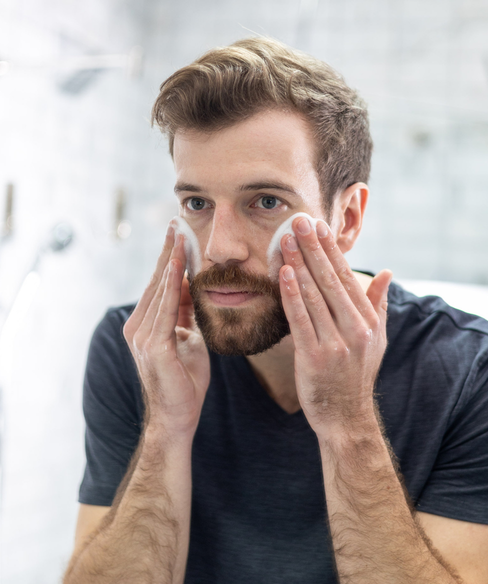
• Alpine Caribou Moss™
• Salicylic Acid
• Prebiotics
• Aloe Leaf Juice
• Kukui Oil
• Calendula Extract
• Niacinamide

• Avobenzone
• Zinc Oxide
• Vitamin E
• Alpine Caribou Moss™
• Aloe Leaf Extract
Protect Against UV Rays and Sun Damage
Just five sunburns more than doubles your chance of developing skin cancer. Our sunscreen products help you avoid damage from the sun’s UV rays without the use of harmful chemicals. They're also packed with antioxidants that help fight off cancer-causing free radicals associated with sun damage and hydrating ingredients that moisturize skin in the face of drying sun exposure.
Which skincare ingredients offer the best sun protection?
There are two ways to block the sun’s rays: reflect them or diffuse them. Ingredients like Avobenzone absorb UV radiation and transform it into heat, removing its harmful effect. Others like Zinc Oxide reflect light altogether. Most sunscreens stop there. Our formulas include antioxidants and vitamins to help fight off free radicals as well as Aloe Leaf Extract for its deep hydrating abilities.
Keep Skin Smooth + Irritation-Free
Skin issues like itching, dryness, and inflammation don’t just look unsightly, they can be uncomfortable and painful too. The right mix of ingredients can nourish and protect your skin to prevent those experiences. It all starts with calming, moisturizing ingredients that help your skin protect itself from bacteria, dry air, pollution, and more.
Which skincare ingredients are best for calming skin?
We use antioxidant-rich Alpine Caribou Moss™ in almost all of our products to defend skin from environmental damage and the irritation it can cause. We also rely on the time-tested Aloe plant to provide its healing, hydrating and calming juice. Vitamin E helps calm the skin and strengthens its natural barrier. In some sunscreen products, we use Squalane to help reduce the chance of redness and inflammation after sun exposure.

• Alpine Caribou Moss™
• Aloe Leaf Extract
• Vitamin E
• Squalane
Our Powerful, Clean Ingredients
-
 Activated Charcoal
Activated CharcoalAbsorbs impurities up to
200x its weight and helps
prevent acne. Also
functions as an exfoliant. -
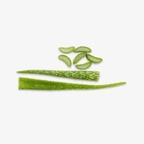 Aloe Vera
Aloe VeraSoothes and hydrates skin
without clogging pores. -
 Alpine Caribou Moss™
Alpine Caribou Moss™Reduces the effect of aging
and guards against pollution
and other stressors. Featured
in nearly all of our products. -
 Coconut-Derived Surfactants
Coconut-Derived SurfactantsBreak down oils and fats
without stripping the skin
of its natural moisture. -
 Corn Starch
Corn StarchWicks away moisture (i.e. sweat) and keeps your skin feeling smooth, dry and comfortable
-
 Jojoba Oil
Jojoba OilPrevents harmful, acne-causing bacteria growth. Softens dry and irritating spots and restores skin to a balanced condition.
-
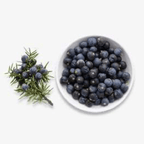 Juniper Berries
Juniper BerriesMildly buff away dead skin
cells and provide ultimate
cleanliness. -
 Safflower
SafflowerNon-irritating ingredient that prompts skin to retain moisture, while removing dirt and oil. Lends
skin a healthy glow and reduces the appearance of wrinkles. -
 Shea Butter
Shea ButterHelps tissue cell regeneration, softens skin and boosts collagen production. Penetrates deep into skin to moisturize and prevent windburn, sunburn and dry, cracked skin.
-
 Vitamin E
Vitamin EBlocks free radicals—a major factor in aging—from the body. Helps reduce appearance of wrinkles and keeps skin looking youthful.
-
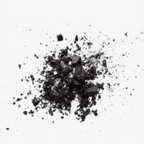 Volcanic Sand
Volcanic SandDeeply exfoliates skin while restoring skin vibrancy. Stimulates blood circulation.
-
 Blueberry Extract
Blueberry ExtractFilled with antioxidants that protect the skin from free radicals which contribute to signs of aging
Ingredients To Avoid In
Skincare Products
If you see these on the back of a label, try one of
our thoughtfully-formulated products instead.
-
Benzalkonium
ChlorideDisinfectant used as a preservative. Associated with severe skin, eye and respiratory irritation and allergies.
Typically found in: lipsticks, moisturizers,
diaper creams, and other cosmetics. -
Coal Tar
Byproduct of coal
processing that adds color
and prevents dandruff.
Known carcinogen.Typically found in: hair
dye, shampoo. -
Ethylenediaminetetraacetic
Acid (EDTA)Disinfectant used as a preservative. Associated with severe skin, eye and respiratory irritation and allergies.
Typically found in: lipsticks, moisturizers,
diaper creams, and other cosmetics. -
Ethanolamines
(MEA/DEA/TEA)Surfactants and pH adjusters.
Linked to allergies, skin toxicity,
hormone disruption and inhibited
fetal brain development.Typically found in: hair dyes, mascara,
foundation, fragrances, sunscreens, dry
cleaning solvents, paint, pharmaceuticals. -
Formaldehyde
Preservative in cosmetics—look for
quaternium-15, DMDM hydantoin, imidazolidinyl urea and several other preservatives. A known carcinogen that is also linked to asthma, neurotoxicity and developmental toxicity.Typically found in: shampoo,
body wash, bubble bath. -
Hydroquinone
Skin-lightening chemical
that inhibits the production
of melanin. Linked to
cancer, organ toxicity and
skin irritation.Typically found in: skin-
lightening creams. -
Methylisothiazolinone and
MethylchloroisothiazolinoneChemical preservatives.
Among the most common
irritants, sensitizers and
causes of contact skin
allergies.Typically found in: shampoo,
conditioner, body wash. -
Oxybenzone
Sunscreen agent and
ultraviolet light absorber.
Linked to irritation,
sensitization and allergies
and possible hormone disruption.Typically found in:
sunscreen, moisturizers. -
Parabens (methyl-, isobutyl-,
propyl- and others)Class of preservatives
commonly used to prevent the
growth of bacteria and mold.
Hormone disruptors, which
may alter important hormone
mechanisms in our bodies.Typically found in: synthetic fragrance, nail polish, hairspray, and plastic materials.
-
Phthalates (DBP, DEHP,
DEP and others)Class of plasticizing chemicals
used to make products more
pliable or to make fragrances
stick to skin. Believed to disrupt the endocrine system and may cause birth defects.Typically found in: synthetic fragrance, nail polish, hairspray, and plastic materials.
-
Retinyl Palmitate and
Retinol (Vitamin A)Nutrient that may damage
DNA and speed the growth of
skin tumors when used
topically.Typically found in: moisturizers, anti-aging skincare.
-
Sodium Lauryl Sulfate
and Sodium Laureth
Sulfate (SLS and SLES)Surfactants that can cause
skin irritation or trigger
allergies.Typically found in: shampoo, body wash, bubble bath.
-
Triclosan and
TriclocarbanAntimicrobial pesticides toxic
to the aquatic environment.
May also impact human
reproductive systems.Typically found in: lipsticks, moisturizers, diaper creams, and other cosmetics.
